Is my skin dry or is it dehydrated? That’s the dilemma, isn’t it? In everyday life, the term “dry skin” is often used interchangeably with “dehydrated skin.” While both may have similar symptoms, they are two different conditions altogether. Confused? Okay, let’s clear your doubts. Read on to find out what dehydrated skin is and how it is different from dry skin.
Table Of Contents
- What Is Dehydrated Skin?
- Dry Skin Vs. Dehydrated Skin: Key Differences
- Signs And Symptoms Of Dehydrated Skin
- How To Determine If You Have Dehydrated Skin
- Taking Care Of Dehydrated Skin
- Choosing The Right Skin Care Product For Dehydrated Skin: A Few Tips
What Is Dehydrated Skin?
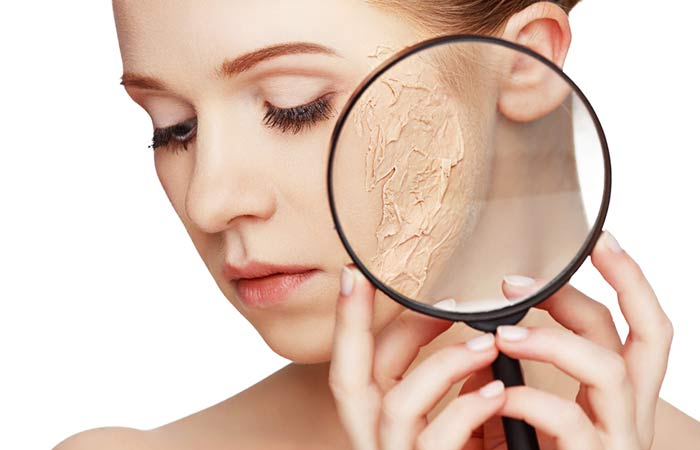
Shutterstock
Simply put, dehydrated skin is skin that lacks moisture and is not well hydrated. It’s a myth that only dry skin is dehydrated – because all skin types can be dehydrated, including extremely oily skin.
Each of us has a different skin type – oily, normal, combination, or dry. All of us have one skin type, but it keeps changing with age, environmental conditions, and the weather. Irrespective of your skin type, your skin cells can be desperate for water. That’s when they get dehydrated. Unlike dehydrated skin, dry skin is primarily caused by underactive sebaceous glands. In other words, when your sebaceous glands don’t produce enough natural oils to maintain the moisture balance of your skin, it turns dry.
Dehydrated skin appears dry and shows all the signs that are similar to that of dry skin. But unlike dry skin, dehydrated skin can cause severe skin issues that need medical attention.
There are a few factors that differentiate dry and dehydrated skin.
Dry Skin Vs. Dehydrated Skin: Key Differences
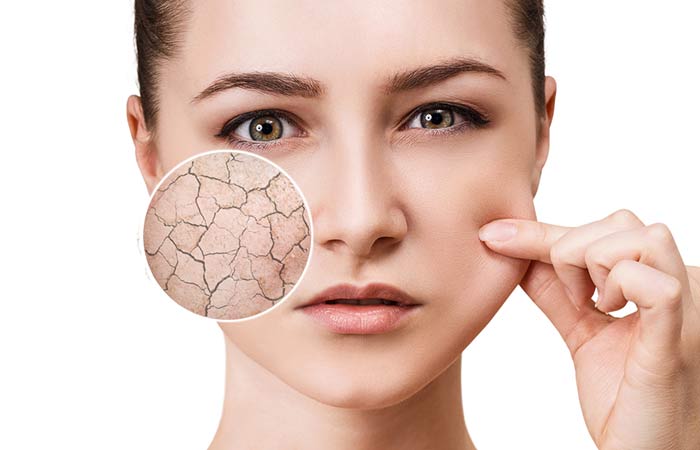
Shutterstock
It is crucial to learn the basic differences between dry and dehydrated skin. Both cause similar symptoms, such as peeling, flakiness, and discomfort. But the following infographic will give you an idea about the key differences.
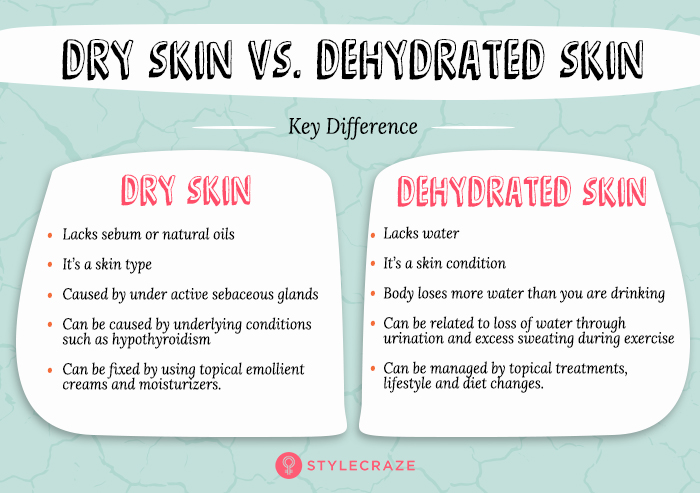
Looking at the specific signs and symptoms of dehydrated skin can give you more perspective on this.
Signs And Symptoms Of Dehydrated Skin
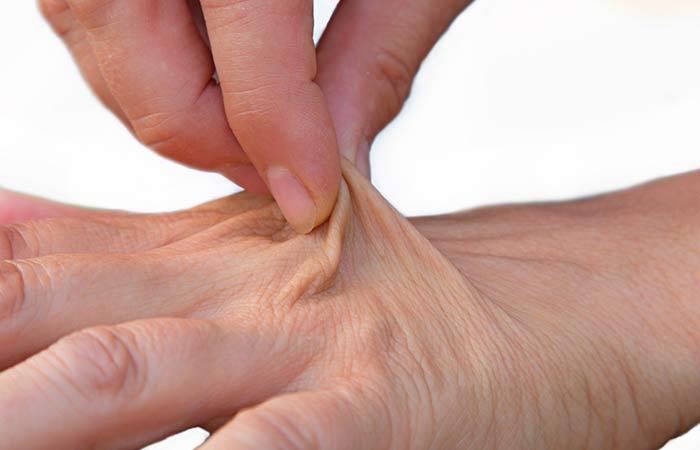
Shutterstock
While dry skin can be flaky, itchy, and extremely uncomfortable, the signs and symptoms of dehydrated skin can be a little different. You may experience the following symptoms if you have dehydrated skin:
- Dullness
- Itchy skin
- Sunken eyes
- Dark circles
- Pronounced fine lines, expression lines, and wrinkles
- Redness
- Inflammation
- Tightness
- Skin sensitivity
- Scaly and rough texture
Severe dehydration may also cause:
- Dry mouth
- Dizziness
- Lightheadedness
- Less frequent urination or dark yellow urine
- Weakness
Apart from these, you are dehydrated if you also show the following symptoms:
- Bad breath
- Less saliva
- Constipation (dehydration worsens it)
- Tendency to faint
- Mood issues (depression and anxiety) (1)
If this is the case, you should visit your doctor immediately. Dehydration can become a serious health issue if ignored.
If you do not know whether your skin is dry or dehydrated, there’s a simple way to determine it.
How To Determine If You Have Dehydrated Skin
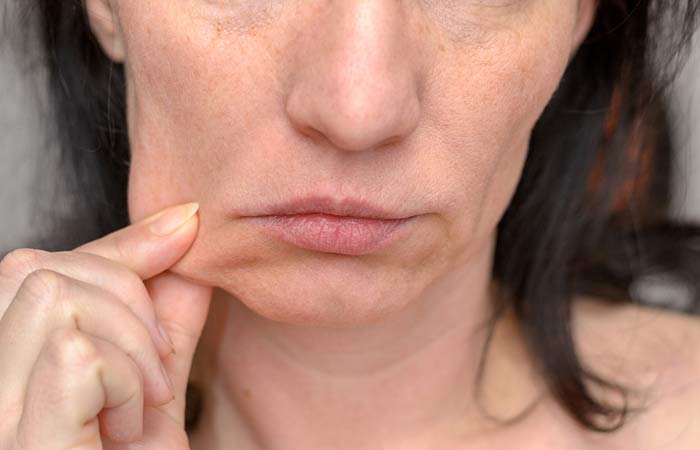
Shutterstock
You can find out whether your skin is dehydrated or not with a simple test (called the pinch test). Here’s how you need to do it:
- Pinch a small portion of the skin on your cheek.
- You may notice a few wrinkles. If it does not bounce back when you let it go, your skin is dehydrated.
There’s yet another simple test you can do to find out if you are dehydrated. Usually, when you press your nail bed, it turns white, and when you release the pressure, the blood rushes back. If you are dehydrated, your nail bed takes longer to become pink or reddish again. To do this test:
- Hold the hand (on which you will perform the test) right above your chest.
- Using your other hand, pinch the nail bed until it turns completely white.
- Release the pressure.
- See how many seconds it takes to normalize (or turn pink again).
If you just realized that you are dehydrated, and your skin lacks the normal moisture levels, don’t panic. You can improve your dehydrated skin and make it glow again. How? Scroll down.
Taking Care Of Dehydrated Skin
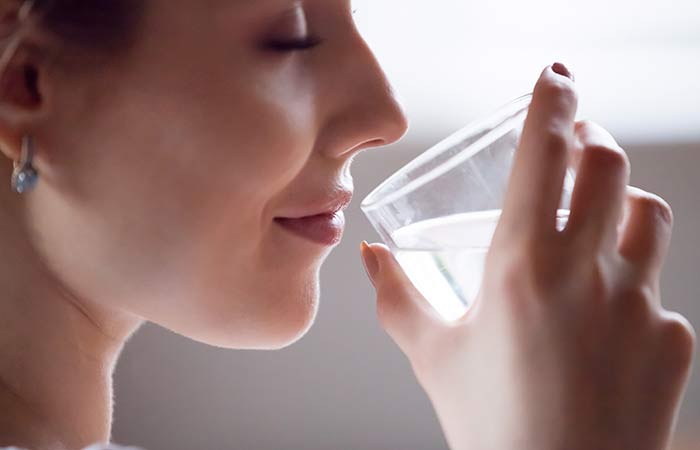
Shutterstock
Once you have determined that your skin is dehydrated and not dry, you can take the following steps to replenish its hydration levels:
- Drink plenty of water. Talk to your doctor to determine how much amount is appropriate for you (as per your activity levels and body weight). It is also crucial not to drink too much water as it might cause loss of essential minerals from your body.
- Cut down on caffeine consumption.
- Quit smoking.
- Reduce (or quit) alcohol consumption.
- Exercise regularly and sip water while you workout.
- Eat more vegetables, fruits, legumes, and plant-based foods.
Apart from these lifestyle changes, follow these skin care tips to take care of your dehydrated skin.
-
Exfoliate Regularly
Dead skin cells, when accumulated, affect the rate at which your skin absorbs moisture. You need to exfoliate your skin at least twice a week to avoid the build-up of dead skin cells.
-
Use A Hydrating Serum
Before you put moisturizer on your skin, apply a serum. Get a serum with hyaluronic acid. Your skin naturally produces this acid, and replenishing it with serum is key to reduce dehydration.
-
Apply A Heavy Night Moisturizer
A heavy, oil-free, and non-comedogenic moisturizer prevents moisture loss. It will keep your skin moisturized and repair it while you sleep.
Using the wrong products can worsen your dehydrated skin. Hence, ensure you pick the right product for your skin. Here’s a guide you can follow.
Choosing The Right Skin Care Product For Dehydrated Skin: A Few Tips

Shutterstock
When picking up products for your skin, be mindful about the ingredients. Certain ingredients may cause skin imbalance and worsen your condition. Here are a few pointers:
- Avoid products with skin-aggravating ingredients such as peppermint, alcohol, menthol, and fragrances. These can dry out your skin further.
- Avoid using abrasive scrubs and cleansing brushes on your skin. These can damage the skin surface.
- Avoid using wrong combinations of products. Although ingredients like vitamin C, AHA and BHA exfoliants, and retinol are excellent for your skin, using these products every day can make your skin look more dehydrated. Use them moderately.
- Use serums and moisturizers that contain antioxidants.
- Always use mild cleansers on your face (preferably soap-free).
Managing dehydrated skin is not an impossible task. Making a few adjustments in your lifestyle and skin care habits can end your ordeal. But despite taking all precautions, if your condition persists, do consult a dermatologist.
How did you deal with dehydrated skin? Do you have any tips or pointers? Do share them with us in the comments section below.
References
-
- “Mild dehydration impairs…“, British Journal of Nutrition, Cambridge University Press
The post Dehydrated Skin: Causes, Symptoms, And How To Care For It appeared first on STYLECRAZE.
0 Comments